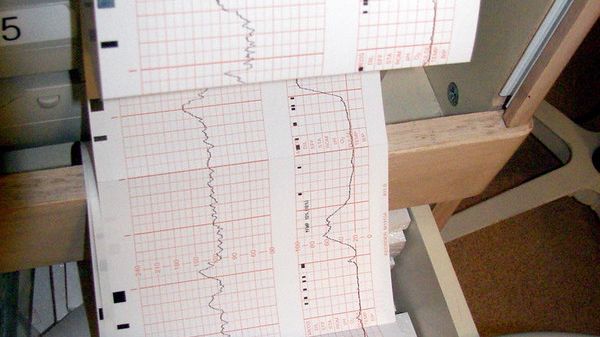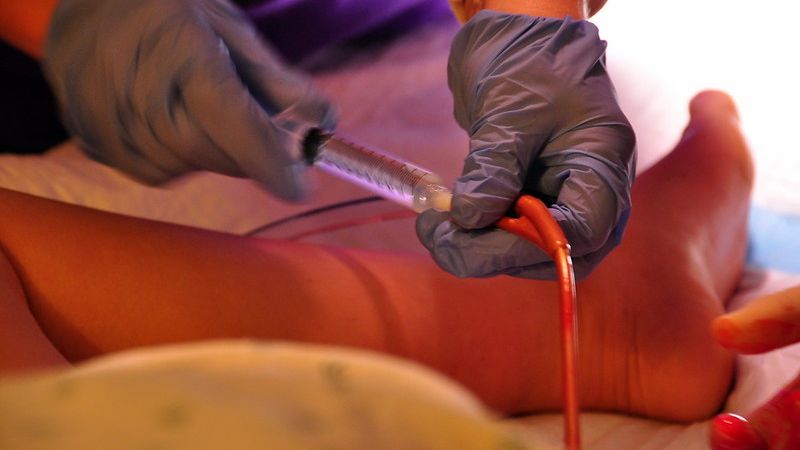Prostaglandins and Cervical Ripening

Prostaglandins are hormones that affect various aspects of the reproductive system to include the softening (ripening) of the cervix prior to labor and delivery.
If a woman does not make enough prostaglandins, or an induction is required and the woman’s cervix is not yet favorable, pharmaceutical prostaglandins and mechanical methods can be used to soften the cervix. The goal is to get the cervix ripe enough to potentially start contractions and further progress dilation and effacement.
Pharmaceutical (medications) and mechanical methods for cervical ripening have been used for decades, are safe, well-controlled, and are very effective. Women should ask their HCP any questions they have related to prostaglandins and cervical ripening - especially prior to an induction.
“Natural” forms of prostaglandins do exist (i.e. semen) but are not effective at ripening and/or softening enough on their own to get labor started. Further, evidence in favor of these “natural” techniques to initiate labor is weak. However, membrane sweeping, which can cause a flood of prostaglandins to the cervix, may have an effect on some women.
All women – no matter what their birth plan is – should be aware of the methods and options for cervical ripening in the event they are recommended near term. This way, women have time to understand the process, the methods used, the risks and benefits of each, and have plenty of time to ask their HCP questions.
Read below for more detailed information.
Background
Prostaglandins are a group of lipids made at sites of tissue damage or infection that are involved in dealing with injury and illness. They also control processes such as inflammation, blood flow, and the formation of blood clots. The initiation of labor is considered an inflammatory process that requires prostaglandins.
They are made by a chemical reaction at the site where they are needed and can be made in nearly all the organs in the body. Anti-inflammatory drugs, such as aspirin and ibuprofen, work by blocking the action of prostaglandin activity, and therefore relieve symptoms of inflammation.
The safety and effectiveness of pharmaceutical and mechanical prostaglandins have greatly improved since they were first used for labor and delivery in the 1960s.
Reproductive System
Prostaglandins are known to regulate the female reproductive system and are involved in the control of ovulation, the menstrual cycle, and the initiation of labor.
Prostaglandins also play a significant role in ripening the cervix, which is necessary prior to dilation and effacement. They dissolve cervical collagen which encourages the cervix to soften and stretch. The body will naturally produce prostaglandins near the end of the third trimester to begin the process of labor.
Note: Some “natural” tips for starting labor include having sex, as the semen contains prostaglandins. However, while these prostaglandins may help ripen the cervix, sex (to include with an orgasm) has not been shown to effectively initiate labor (more here).
In some cases, the body will not create enough prostaglandins to soften the cervix. These women may need medical assistance to help this process (and to avoid cesarean delivery).
For example, prior to scheduled induction of labor, some women will have an “unfavorable” (unripe/firm) cervix. Therefore, cervical ripening is a necessary first step. Pharmaceutical prostaglandins or mechanical methods can be used.
Pharmaceutical Overview
Pharmaceutical forms of prostaglandins tend to be used more often than mechanical methods.
The major pharmacological methods are prostaglandin E2 (PGE2 – dinoprostone; most common), and prostaglandin E1 (PGE1 – misoprostol).
Dinoprostone: Cervidil®, Prepidil®, Prostin E2®
Misoprostol: Cytotec®, Misodel®, Arthrotec®, Arthrotec 50®, ACT Diclo-Miso®
The dose, number of doses, method of dose, and time between doses varies considerably among the different types.
Vaginal administration is the most common form used in current practice (some may be taken by mouth). Prostaglandin preparations for vaginal administration include gels, tablets, suppositories, pessaries, or inserts.
Note: Prostaglandins may need to be avoided in women with glaucoma or asthma (may trigger bronchospasms), and possibly those with a prior cesarean delivery.
Dinoprostone
Dinoprostone is the most common and preferred method of cervical ripening, has been administered intravenously, orally, and vaginally for induction of labor, and is highly effective.
Dinoprostone acts on the cervix by dissolving its collagen structural network.
Vaginal dinoprostone is the preferred administration route, and numerous studies indicate there are hardly any differences between different vaginal tablets, gels, or pessaries. However, these studies are limited in number and uncertainties remain about how to best apply these different types in terms of dosage and timing.
Dinoprostone can cause side effects such as nausea, vomiting, diarrhea and fever (occurs in less than 1% of patients).

Dinoprostone gel: Prepidil® (0.5 milligrams (mg)/intracervical)
U.S. Food and Drug Administration (FDA) approved for ripening an unfavorable cervix in pregnant women at or near term with a medical or obstetrical need for labor induction.
Additional information is located here. (FDA link)
Generally, once the gel is administered, the woman lies down for at least 30-minutes and doses can be repeated every 6 hours, with a maximum of 3 doses in a 24-hour period.
However, an amniotomy ("breaking the waters") is associated with a shorter induction of labor–to-birth time compared with the use of repeat doses. Further, administering more dinoprostone appears to have no clinical advantage.
Dinoprostone insert: Cervidil® (10 mg/controlled release; 0.3 mg/hour over a 12-hour period).
FDA approved for the initiation and/or continuation of cervical ripening in patients at or near term in whom there is a medical or obstetrical indication for the induction of labor.
Additional information is located here. (FDA link)
The vaginal insert of dinoprostone is a thin, flat, rectangular polymeric wafer held within a small, white mesh polyester sac. The sac has a long tail to allow easy removal from the vagina. Following insertion, the woman generally lies down for 2 hours; the insert is removed after 12 hours or before labor onset.
All pharmaceutical versions of prostaglandins carry a risk of excess uterine activity, or uterine tachysystole.
Uterine tachysystole is defined as five or more contractions in 10 minutes for two consecutive 10-minute periods, and hypersystole as a single contraction of at least two minutes' duration.
Excessive uterine activity may be associated with fetal distress, and in a small number of cases can lead to uterine rupture.
A literature review of 69 studies published in July 2021 estimated the prevalence of uterine rupture when PGE2 is used for cervical ripening and labor induction. The pooled prevalence rate of uterine rupture is estimated to range between 2 and 9 out of 1000 women with 1 prior low transverse cesarean. The prevalence among women with an unscarred uterus (no prior cesarean) is extremely low, reaching at most 0.7/100.000.
It is usually recommended that women with a prior cesarean who are under going labor induction in a subsequent pregnancy try mechanical methods that do not incur this risk (described below under "Mechanical Methods").
The true risk of excess uterine activity and the use of dinoprostone is unresolved, as not all studies report this activity, and its definition is quite inconsistent or not defined at all. Further, several prevention techniques are used to minimize risk, to include removal of the insert.
Only one cycle of the controlled release form is used in a 24-hour period and allows for easy removal in case of uterine tachysystole or fetal heart rate changes, which reverses these complications. In one study, cases of excess uterine activity reversed within 2 to 13 minutes of removal of the insert.
Pharmaceutical versions of prostaglandins and oxytocin are not given at the same time and are spaced apart. Dinoprostone must be removed before oxytocin administration is initiated and the woman’s uterine activity can be carefully monitored. The controlled-release requires only a 30-minute delay before the initiation of oxytocin upon its removal, while gel usually requires an interval of six hours.

Misoprostol
Misoprostol is another commonly used medication for cervical ripening. Due to its wide-ranging applications in reproductive health, misoprostol is on the World Health Organization Model List of Essential Medicines.
Misoprostol is a synthetic prostaglandin E1 analogue officially approved for peptic ulcer prevention. It is used off-label (United States, United Kingdom, Australia, New Zealand, and Canada) and for a variety of medical reasons including management of miscarriage, termination, induction of labor, cervical ripening before surgical procedures, and the treatment of postpartum hemorrhage.
Misoprostol has an effect on the uterus and cervix, and not the fetus. According to the FDA, misoprostol has not been shown to be “fetotoxic or teratogenic in rats and rabbits at doses 625 and 63 times the human dose, respectively".
Misoprostol is very effective for the induction of labor and may result in a high probability of vaginal delivery within 24 hours, a possible reduced need for oxytocin, and a lower incidence of cesarean section.
Different routes of administration have advantages and disadvantages. Oral misoprostol achieves faster action, whereas vaginal administration is slower, has a more lasting effect, and overall, may be more effective. Misoprostol’s effects are also dose dependent and side effects include nausea, vomiting, diarrhea, fever, and chills (more common with the oral route).
Common dose recommendations include 50 micrograms (mcg) orally, or the preferred route and dosage of 25 mcg vaginally. The vaginal dose is generally repeated every 4 to 6 hours depending on uterine activity.

Oral misoprostol usually comes in tablets of 100 mcg or 200 mcg, but doses over 50 mcg are not recommended. Therefore, the tablet is usually divided with a pill cutter, a technique that makes accurate dosage difficult.
The largest risk in the use of misoprostol is the possibility of uterine tachysystole and hypersystole (defined above).
However, according to a Cochrane review published in June 2021, the best available evidence suggests that low‐dose oral misoprostol (25 mcg or less) probably has many benefits over other methods for labor induction, including lower risks of uterine tachysystole than when misoprostol is given vaginally.
Uterine rupture is also a rare, but a possible complication; misoprostol is not advised for women who have had a previous cesarean section. The risk of uterine rupture increases with advancing gestational age, prior uterine surgery, including cesarean delivery, and being pregnant with multiples.
Pelvic pain, meconium passage, meconium staining of amniotic fluid, retained placenta, severe genital bleeding, shock, fetal bradycardia, and fetal and maternal death have also been reported.
Mechanical Methods Overview
Mechanical methods for producing prostaglandins were the first methods used for cervical ripening and labor induction and are still widely used today, although pharmaceutical methods are used much more frequently. Mechanical methods all use some form of local pressure on the cervix that stimulates the release of prostaglandins.
Mechanical stretching of the cervix enhances uterine activity – known as the Ferguson reflex – which brings about the continual progression of contractions.
Mechanical methods are less effective than pharmaceutical methods but are less likely to result in excess uterine activity and other side effects, which may make them more suitable options for women with a history of cesarean section/uterine surgery. The major risk of mechanical methods is the potential for increased maternal and neonatal infection – however, this is rare.
The most popular mechanical methods include catheter balloon(s) with or without saline, hygroscopic cervical dilators, and membrane sweeping.
A membrane sweep (or stripping) is considered a mechanical form of prostaglandin production; however, the cervix needs to be dilated enough for an HCP’s finger to pass through the cervical canal.
Membrane sweeping involves the HCP placing a finger through the cervix and rotating it several times to separate the membranes from the uterine wall (the richest source of prostaglandins) and internal os of the cervix, to which it is attached. The purpose is to potentially initiate the start of labor, or progress labor that has already started (read Membrane Sweeping).
Balloon Catheters
Balloon catheters have been used for more than 50 years and have experienced a recent reemergence in clinical practice.
Foley (single) and double balloon catheter devices provide mechanical pressure directly on the cervix and lower uterine segment as the balloon(s) is filled (Foley catheters are normally used to drain urine from the bladder).
In labors that start on their own, it is believed the top of the baby’s head (or presenting part) engages the cervix through downward pressure. This engagement of the cervix sends nerve impulses to the hypothalamus, which then releases oxytocin from the pituitary gland, beginning contractions. The goal of catheter balloons is to mimic this process.
The two catheters available are the Foley catheter (off-label use) and the double balloon catheter, which is licensed for use in the induction of labor by the FDA.
A small soft plastic tube is inserted through the cervix and a tiny balloon is inflated with saline, putting pressure on the cervix. Additional downward tension can be created by taping the catheter to the thigh or adding more saline.
This image contains triggers for: Procedure, Real Delivery
You control trigger warnings in your account settings.
If contractions start, waters break, or dilation occurs, the balloon may fall out before it is due to be removed (usually within 12 to 24 hours, or less).
Extra-amniotic gel can also be administered via the catheter inserted through the cervix into the extra-amniotic space but is currently not common practice.
The balloon usually falls out by itself around 4 cm, about the time women enter the active phase of labor. It is possible the balloon catheter alone can place a woman into regular, active labor without the augmentation of oxytocin. If the balloon falls out and contractions have not begun or are still weak and irregular, oxytocin is usually started.
A low-lying placenta is an absolute contraindication to the use of balloon catheters, as well as antepartum hemorrhage, rupture of membranes, and evidence of lower tract genital infection. The double balloon catheter, which puts pressure on both the internal os and external os of the cervix, is not recommended for women with previous cesarean section.
Regarding pain, several studies have indicated that the procedure is tolerated well but may be uncomfortable. Women included in at least one study were not bothered by the placement of the device or the presence of the catheter. However, balloon catheters are associated with significantly less pain than pharmaceutical prostaglandins, and single balloon catheters may cause less pain and discomfort than double balloon catheters.
A graphic of a double balloon catheter in use is located here (page 2). In a single balloon catheter, the balloon is only entered into the extra-amniotic space, above the cervix.
A provider-produced video explanation of the catheter placement can be viewed below. Note that technique may vary slightly by provider.
Dilators
Hygroscopic (absorbs moisture) dilators absorb cervical mucus, causing the device to expand within the cervix which provides gradual, controlled mechanical pressure. The most commonly used hygroscopic dilators are laminaria – thin, slender rods made of synthetic material. These rods are commonly used prior to dilation and curettage procedures.
The main advantages of using hygroscopic dilators include outpatient placement (HCP's office) and no fetal heart rate monitoring requirements.
Hygroscopic dilators are safe but are less effective and may offer few benefits compared to prostaglandins.
Action
Pregnant women should refer all questions related to prostaglandins, cervical ripening methods, and induction and augmentation of labor to their HCP.
All women – no matter what their birth plan is – should be aware of the methods and options for induction and augmentation of labor in the event they are recommended near term or during labor. This way, women have time to understand the process, the methods used, the risks and benefits of each, and have plenty of time to ask their HCP questions. They will also feel more confident in their decisions and have a better understanding of why certain options are used and when.
Complete knowledge of induction and augmentation methods can significantly reduce fear and anxiety, give women a better sense of control, and lead to a better birth experience.
Resources
Prostaglandins (You and Your Hormones; Society for Endocrinology)
Methods for Cervical Ripening and Induction of Labor (American Family Physician)
Labor Induction (includes prostaglandins) (American College of Obstetricians and Gynecologists)